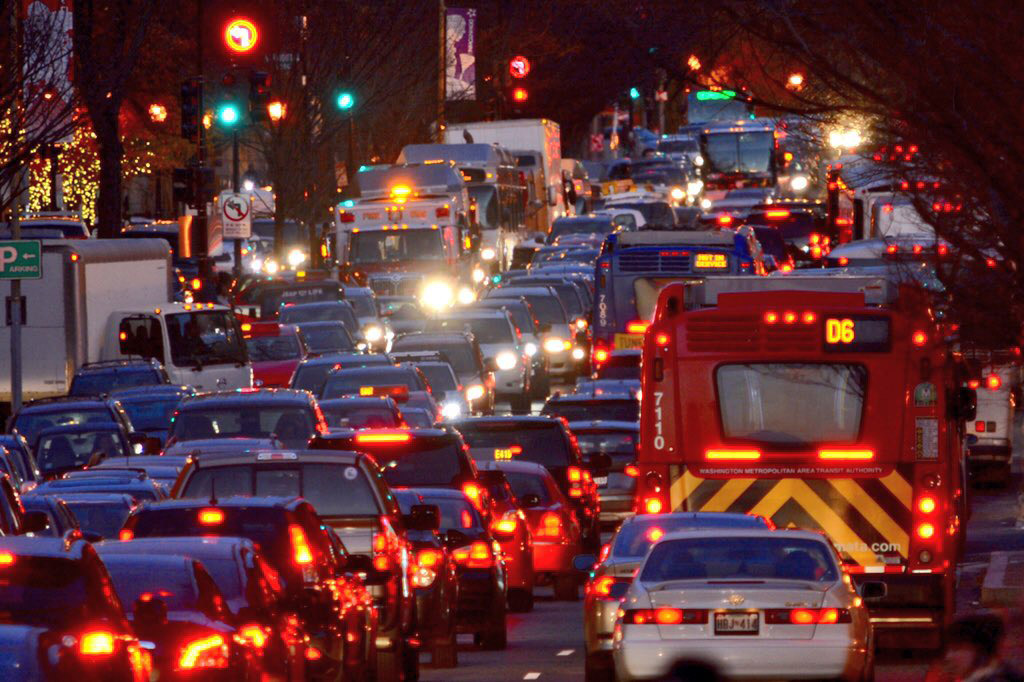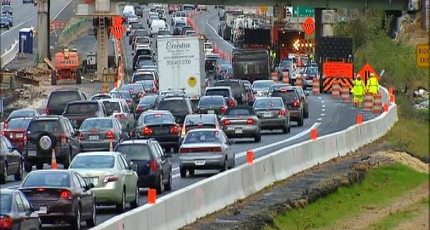The percentage of commuters taking cars to work ticked downward between 2009 and 2015 – from more than 76 percent to just over 75 percent. Public transportation saw a nominal gain, hovering around the 15 percent mark. The percentage of people working from home increased slightly to 5.6 percent in 2015. Click here if you can’t see the chart.
The longest average commute in the seven areas WTOP surveyed was in Prince George’s County – which clocked in at 36.5 minutes. That’s up almost a minute from where it was in 2009. Arlington Co. commuters racked up the shortest average commute – 28.1 minutes – although that’s up nearly two minutes from the average Arlington commute in 2009. Click here if you can’t see the chart.
Most of the seven areas WTOP surveyed saw increases – even if only slight – in the length of the average commute. Prince George’s County commuters experience the longest average commute – more than 36 minutes. That’s an increase of about a minute from where it was in 2009. Arlington County commuters enjoy the shortest average commute – 28.1 minutes. The Alexandria commuters’ average trip to work also jumped almost two minutes – from 29 minutes to nearly 31 minutes. Click here if you can’t see the chart.
Nearly 6 percent of residents of Arlington County and Fairfax County report working from the home – the highest percentage of the seven areas surveyed. That’s followed 5.6 percent of workers in Montgomery County. With the exception of Prince George’s County, all of the seven areas WTOP surveyed saw gains in the percentages of people working from home. Arlington and Fairfax which now lead the pack in teleworkers both jumped 1 percent since 2009. Click here if you can’t see the chart.
WASHINGTON — It’s not your imagination — traffic around the capital is getting worse, and the average length of time D.C.-area commuters spend on their trek to work keeps climbing.
A WTOP review of U.S. Census data for seven counties and cities in the D.C. area shows the average commuter is spending more time getting to work, whether they live in the Virginia or Maryland suburbs.
In the immediate Washington area, drivers in Prince George’s County spend the most time in their vehicles for the morning commute – 36.5 minutes. That’s only up a minute from 2009, but all those minutes add up. That was followed by Montgomery County at 34.5 minutes, up from 33 minutes in 2009. The average Fairfax County commute clocked in at 32 minutes, up from 31 minutes in 2009.
Arlington County drivers enjoy the shortest commute, which is shorter than a Seinfeld rerun — 28 minutes. Still, that’s up from the average of 26 minutes Arlington residents reported in 2009.
One bright spot: the percentage of Washington-area commuters reporting hour-plus trips to work actually dropped – from 9.3 percent in 2009 to 8.7 percent in 2015.
The data comes from the Census’ American Community Survey. The most recent available tracks commuting patterns through the end of 2015.
WTOP selected seven specific areas in the region to examine the how, when and where of the D.C.-area commute. The areas included: D.C., Alexandria, Virginia; Arlington County, Virginia; Fairfax County, Virginia; Montgomery County, Maryland; Prince George’s County, Maryland; and Silver Spring, Maryland. The aim was not to provide a exhaustive look at regionwide commuting but instead a snapshot of interesting commuting patterns.
Driving on the decline
From D.C. to Fairfax County, from Alexandria to Rockville, the percentage of people who said they hop in the car to get to work trended downward between 2009 and 2015, according to the census survey data.
Overall, Fairfax County remains king of the cars, with the highest percentage of morning motorists. More than 81 percent of commuters there reported driving to work. Still, that’s down from 84 percent in 2009.
In Alexandria, the percentage of drivers declined from more than 70 percent to about 67 percent between 2009 and 2015. And in D.C., which has the smallest share of car commuters, less than 40 percent of workers reported driving to work in 2015 — compared to 43.5 percent in 2009.
The disappearing drivers are part of a much broader, long-term trend. The Metropolitan Washington Council of Governments, which studies regional commuting patterns on a regular basis, reports that single-occupant vehicle trips in the region have been on the decline for at least the past decade.
The organization’s “State of the Commute” report — the most recent version was released in September — reported that since 2004, the percentage of commuters regionwide driving alone to work declined at least 10 percent from 71 percent to 61 percent.
Still, driving has remained “the major mode” in which the D.C. region’s commuters get to work, said Kanti Srikanth, the organization’s director of transportation planning, in an interview with WTOP.
Commuting times climb upward
Despite the declining share of drivers, the length of the average commute in those areas WTOP surveyed continued to tick upward.
The longest average commute was in Prince George’s County at 36.5 minutes — up more than a minute from 2009. That was followed by Montgomery County at 34.5 minutes — up from 33 minutes in 2009. The average Fairfax County commute clocked in at 32 minutes, up from 31 minutes in 2009.
Arlington County enjoys the shortest average commute, which clocked in at about 28 minutes. Even that’s up, however, from the average 26-minute commute Arlington residents reported in 2009.
In addition to the longest average commute, Prince George’s County also saw the highest percentage of commuters reporting their trip to work took an hour or more in 2015. Nearly 20 percent of county residents reported hour-plus slogs in 2015 — up from 18.6 percent in 2009.
That’s likely a reflection of the fact that more Prince George’s County residents report traveling outside their county for their jobs than many other areas in the D.C. region.
On the other hand, the percentage of D.C. commuters reporting hour-plus trips to work dropped from 9.3 percent in 2009 to 8.7 percent in 2015.
What’s behind the commuting-time uptick?
The actual amount of travel undertaken by commuters since 2000 — in terms of distance — has actually declined, according to another long-term survey of commuting patterns undertaken by the Council of Governments, known as the Regional Travel Trends analysis. In particular, the actual vehicle miles traveled per capita decreased by about 10 percent, according to that analysis. Logically, since the distance declined, the time spent commuting should have also decreased.
“The only thing that would offset that is if there are increased levels of congestion,” Srikanth said. “So, even though I may be traveling less, if the congestion has increased, then my travel would not have changed.”
Public transit mostly flat
While driving as a percentage of commuters is down, that doesn’t necessarily mean all those drivers handed over the car keys for SmarTrip cards. In fact, the percentage of commuters taking public transportation between 2009 and 2015 stayed relatively flat in most areas, with one notable exception.
Overall, D.C. reported the highest percentage of commuters hopping on Metro or catching a bus to work — more than 37 percent. But despite an uptick in 2013 and 2014, that’s only slightly higher than where it was back in 2009. Other areas, such as Arlington and Prince George’s counties, saw nominal declines or stayed flat.
Fairfax County, however, reported a 1 percent uptick in the percentage of commuters taking public transportation to work — the only area of the seven WTOP surveyed to actually report real gains in public transit adoption. Fairfax’s growing share of transit takers probably makes sense given that Metro opened stops in the county thanks to the Silver Line during the time of the survey period.
Still, Fairfax County has one of the lowest percentage of public transit takers in the region — just 9.8 percent. And it should be noted, the data only goes through the end of 2015, so it’s still too soon to see in this set of data whether Metro’s 24/7 repair work, which hit hardest the lines that service Fairfax County, will translate into losses in ridership in Fairfax County.
Overall, Metro recorded a 5 percent drop in riders between 2010 and 2015 and even steeper ridership declines since the January 2015 L’Enfant Plaza deadly smoke incident and the start of 24/7 work zones to correct safety issues.
Early-bird commuters
The census also includes a question surveying commuters on when they leave their houses for work. The early birds in the D.C. region were in Prince George’s County, where nearly 40 percent of commuters said they left their homes before 7 a.m. In Arlington County and D.C., just 17 percent of commuters said they hit the road before 7 a.m.
And about one-third of commuters in D.C. and Arlington — the highest proportion of the seven areas WTOP surveyed — didn’t report leaving home for work until 8 a.m.
Working from home
Another interesting commuting trend?
By 2015, there were many more people in the area foregoing the morning commute entirely — because they work from home.
About 5.8 percent of workers in Fairfax County reported working from home in 2015 — up from 4.5 percent in 2009 and tied with Arlington County as the area with the highest percentage of teleworkers. In 2009, 4.8 percent of Arlington County commuters reported teleworking.
The percentage of teleworkers in Alexandria increased from 3.4 percent in 2009 to 5 percent and ticked up from 4.7 percent to 5 percent in D.C.
Just 2.6 percent of workers in Prince George’s County reported working from home — about the same number as in 2009.
Get the latest traffic updates on WTOP’s traffic page and listen every 10 minutes (on the 8s) on 103.5 FM.








